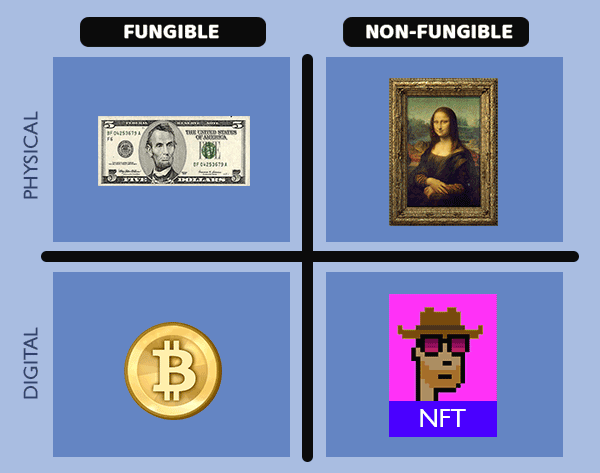Non-fungible tokens (NFTs) have received lots of airtime from the media this year. Why?

What is a Non-Fungible Token or NFT?
Non-fungible is an economic term that describes things that have unique properties and are not interchangeable with other items.
When the term ‘NFT’ is used today it often describes ownership of a digital collectable. The proof of ownership is kept in the form of a unique token on the same blockchain technology as the cryptocurrency Ether allowing it to be verified and traced when necessary.
What type of Digital Assets are considered an NFT?
Anything that is digital can have a token or NFT associated with it, including pictures, videos, artwork, text and even cartoon characters.
This past spring, the digital artwork “Everydays: The First 5000 Days” by the artist Beeple was purchased for over $69 million (paid in cryptocurrency) at a Christie’s auction. Visa recently spent $150,000 (again, paid in cryptocurrency) for a ‘Cryptopunk’, a pixelated digital image of a woman with a mohawk. Below are the announcements of these purchases on Twitter from both Christie’s and Visa.
The list of what can include an NFT is almost limitless. Jack Dorsey, the CEO of Twitter sold his first tweet as an NFT. In late 2020, the NBA started ‘Top Shots’ which allows fans to purchase, sell and trade video highlights of NBA and WNBA players. There are online games that include purchasing NFTs, like Cryptokitties where it can cost thousands of dollars (purchased in the cryptocurrency Ether) to buy a “kitty” to collect, breed and sell as part of the game.
Is an NFT different from any other collectable?
Only time will tell if NFTs are different but when we use history as a guide, there are many similarities to other types of collectables. Fine art, stamps, coins, trading cards, comic books and toys are just a few of the things sought, purchased, and sometimes sold by collectors over the years. NFTs have just taken the concept of these types of collectables into a digital format.
All collectables see values rise and fall based on supply and demand, and NFTs are no different. In the future, some may retain or even gain in value, while many will see values decrease as the NFT market matures and the current craze subsides. Just because this is a digital ‘asset’ does not mean “it is different this time”. It really isn’t different this time.
Are NFTs an investment?
Any type of collectable is difficult to think as an investment for several reasons. The value is often based not only on condition and scarcity, but also demand for the item. Trends drive demand as much as another other factor and trends can and often do change over short periods of time. The trend driving demand for any NFT will surely come to end and it is difficult to see with any clarity which NFTs will gain in value over the long-term period, and which will lose most, if not all of their value.
At Prato Capital, we do not view NFTs or any other collectable as a reliable part of a balanced and diversified portfolio. It is impossible to forecast the expected returns of NFTs as a group or even individually over the long-term and this can make a financial plan much less reliable.

